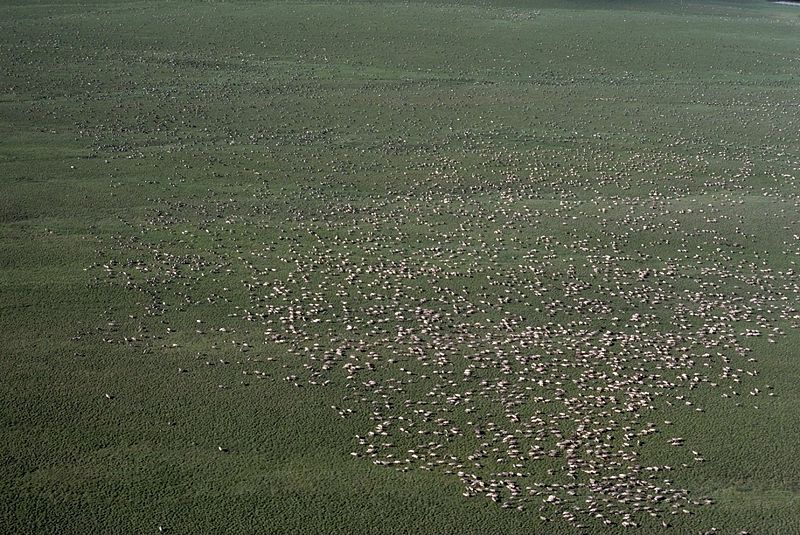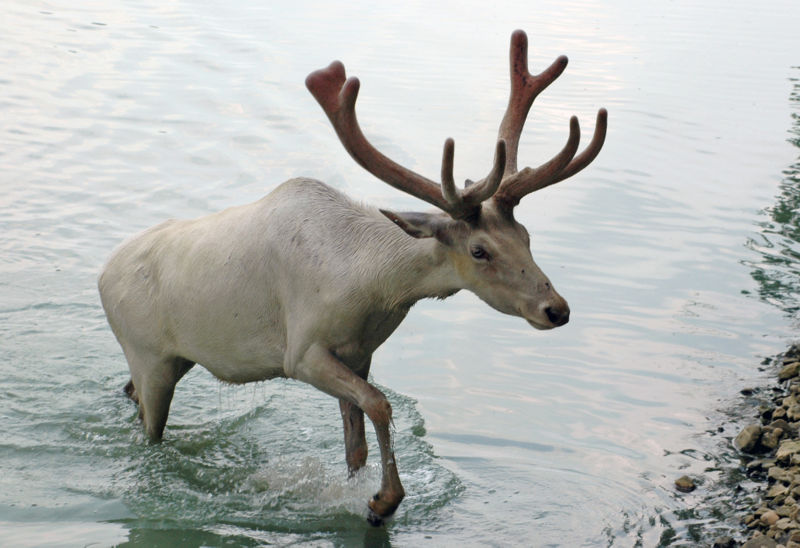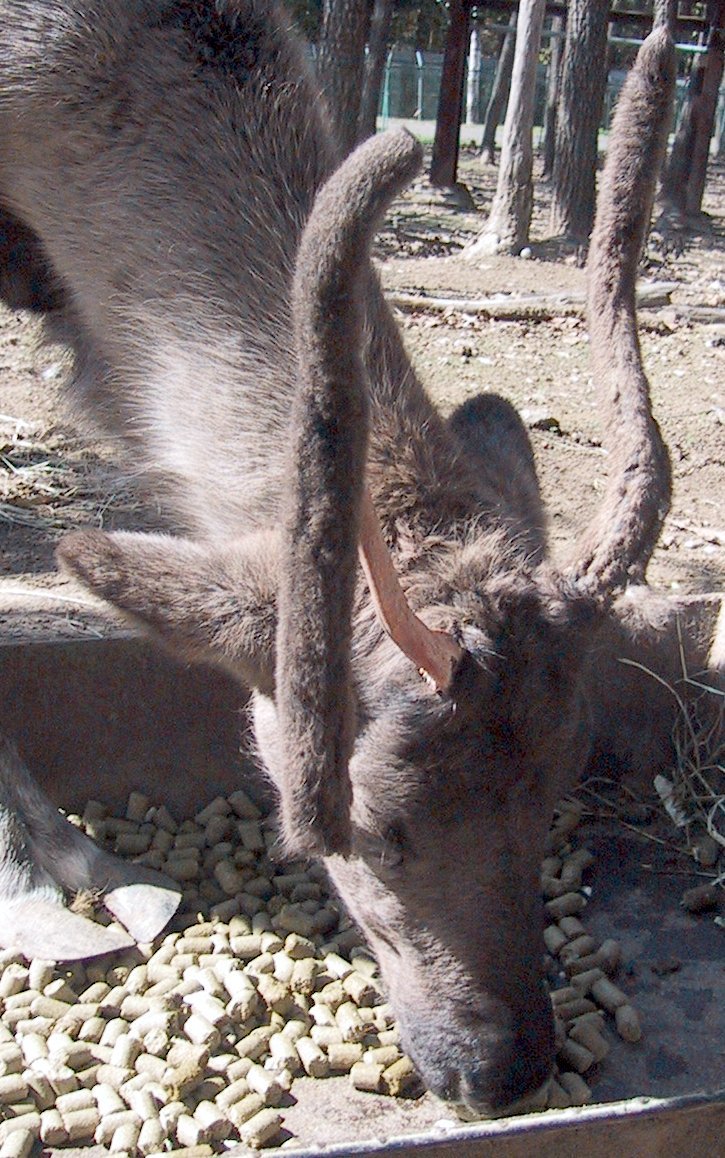Reindeer have many unique adaptations that allow for their
efficient survival in cold Arctic and subarctic boreal forest
climates. First and foremost,
they possess a coat that provides insulation against cold temperatures.
They have hollow hairs that taper down tight against the body to trap
heat and cover the short, curly underfur, and also enhance
their swimming ability by keeping them afloat.
Their fur is able to insulate so well that falling snow does not melt on
their backs. Running reindeer, even on a cold day, can easily become overheated.2
The hooves are large, and used as a support when walking on soft
tundra and snow. In the winter,
their foot pads shrink, become hard, and are covered with fur to function as
snowshoes and better aid in walking on snow and ice.5

Reindeer are also able to travel distances greater than that of any other
terrestrial animal! They move in
packs of thousands, and can travel 5,000 kilometers a year, running at speeds up
to 48 miles an hour and swimming up to 6 miles per
hour. They are constantly moving to
find new pastures with food, and escape from inclement weather or
predators.
This makes reindeer
unique in that most other deer species do not stray far from their birthplace.2
Most migrations occur in the spring
and fall, with those in the spring taking the reindeer to calving and summer
feeding grounds. Reindeer are
found
in the largest groups in the summer, and this behavior is thought to have
adapted to prevent being bothered by bot flies, gnats, and mosquitoes that bite
and plague the individuals. In the
fall they migrate back to the forests to find food and shelter from cold winter
storms. During the winter, the size of groups decrease, and males of herds will
fight other males to keep them from mating with females of their herd; some
fights can result in death!17

Most reindeer spend winters in forested areas
where they are able to more readily find food
under the snow, possessing an incredibly strong sense of smell to do so.
However, their senses of sight and hearing are not well developed.
Their front hooves provide them with the ability of digging craters to
expose buried food. In warm weather
they climb up mountain slopes to enjoy the cool snow of the high altitudes.
Reindeer are able to communicate with one another vocally, visually, and
chemically! The noises they
make to communicate include a snort of alarm, bawl, and grunting roar by males
during the rut.17
 Both
male and female reindeer possess antlers—the only species of deer in which this
occurs! The sharp points of antlers
can be used as a weapon to fight off predators, and pregnant females may use
them to prevent other reindeer from eating their food.
Antlers contain forward-projecting palm-like portions that can function
as shovels. Male reindeer shed their
antlers after the rut, aka breeding season (November and December), and females
keep their antlers until May or June when they give birth to their calves.
New antlers begin to grow back as soft knobs with a coating referred to
as velvet. After antlers stop growing, the velvet dries and falls away.
Reindeer polish their antlers by rubbing them against branches and
shrubs.2
Both
male and female reindeer possess antlers—the only species of deer in which this
occurs! The sharp points of antlers
can be used as a weapon to fight off predators, and pregnant females may use
them to prevent other reindeer from eating their food.
Antlers contain forward-projecting palm-like portions that can function
as shovels. Male reindeer shed their
antlers after the rut, aka breeding season (November and December), and females
keep their antlers until May or June when they give birth to their calves.
New antlers begin to grow back as soft knobs with a coating referred to
as velvet. After antlers stop growing, the velvet dries and falls away.
Reindeer polish their antlers by rubbing them against branches and
shrubs.2
Reindeer in Alaska today are larger than those from the
original stock imported into North America from Siberia in 1891.
Alaska has a better range

and climate for the reindeer than in Siberia;
it is not as bitter, harsh, and desolate.
Thus, the Alaskan herds can average higher numbers of reindeer
(tens of
thousands), exhibiting another environmental
adaptation. The introduction of wild caribou
into some of the herds has also subsequently
increased the reindeer size in those herds.11
Think this is neat? Check out what
reindeer eat in their environment next!
Home
Back
to top

 Both
male and female reindeer possess antlers—the only species of deer in which this
occurs! The sharp points of antlers
can be used as a weapon to fight off predators, and pregnant females may use
them to prevent other reindeer from eating their food.
Antlers contain forward-projecting palm-like portions that can function
as shovels. Male reindeer shed their
antlers after the rut, aka breeding season (November and December), and females
keep their antlers until May or June when they give birth to their calves.
New antlers begin to grow back as soft knobs with a coating referred to
as velvet. After antlers stop growing, the velvet dries and falls away.
Reindeer polish their antlers by rubbing them against branches and
shrubs.2
Both
male and female reindeer possess antlers—the only species of deer in which this
occurs! The sharp points of antlers
can be used as a weapon to fight off predators, and pregnant females may use
them to prevent other reindeer from eating their food.
Antlers contain forward-projecting palm-like portions that can function
as shovels. Male reindeer shed their
antlers after the rut, aka breeding season (November and December), and females
keep their antlers until May or June when they give birth to their calves.
New antlers begin to grow back as soft knobs with a coating referred to
as velvet. After antlers stop growing, the velvet dries and falls away.
Reindeer polish their antlers by rubbing them against branches and
shrubs.2

